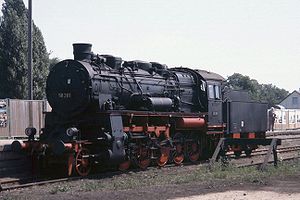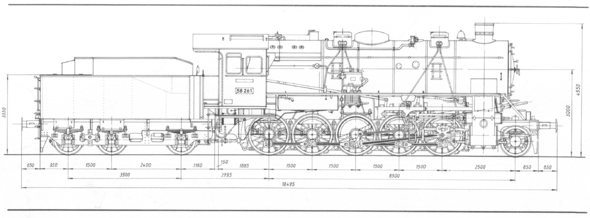Prussian G 12
| G12 (Prussia, Alsace-Lorraine, Baden, Württemberg) XIII H type 1919 (Saxony) DR series 58 2–5, 10–21 ÖBB series 658 PKP series Ty 1 BDŽ series 13 |
|
|---|---|
|
DR 58 261 in Potsdam (1993)
|
|
| Numbering: | DR 58 201-225, 231-272, 281-303, 311-318, 401-462, 501-543, 1002-2148 |
| Number: | 1478 |
| Manufacturer: | Henschel and others |
| Year of construction (s): | 1917-1924 |
| Retirement: | 1953 (DB) 1976 (DR) |
| Type : | 1'E h3 |
| Genre : | G 56.17 |
| Gauge : | 1435 mm ( standard gauge ) |
| Length over buffers: | 18,495 mm |
| Empty mass: | 85.4 t |
| Service mass: | 95.7 t |
| Service mass with tender: | 141.3 t (with tender 3 T 20 and full stocks) |
| Friction mass: | 82.5 t |
| Wheel set mass : | 16.7 t |
| Top speed: | 65 km / h |
| Indexed performance : | 1,133 kW / 1540 PSI |
| Starting tractive effort: | ≈ 253 kN |
| Driving wheel diameter: | 1400 mm |
| Impeller diameter front: | 1000 mm |
| Number of cylinders: | 3 |
| Cylinder diameter: | 570 mm |
| Piston stroke: | 660 mm |
| Boiler overpressure: | 14 bar |
| Number of heating pipes: | 189 |
| Number of smoke tubes: | 34 |
| Heating pipe length: | 4800 mm |
| Grate area: | 3.88 m² |
| Radiant heating surface: | 14.19 m² |
| Tubular heating surface: | 176.66 |
| Superheater area : | 68.42 m² |
| Evaporation heating surface: | 190.85 m² |
| Tender: | pr 3 M 20, pr 2'2 'M 31.5, sä 3 M 21 |
| Water supply: | 20.0 / 21.0 / 31.5 m³ |
The class G 12 of the Prussian State Railways is a series of freight locomotives with the axle formula 1'E.
history
It was designed because during the First World War it had proven to be very disadvantageous for the maintenance and operation of the locomotives that each regional railway had its own locomotive types and that there was no standardization. The Army Railways needed a fast, powerful freight locomotive that did not have too high an axle load. The G 12 was based on the Prussian G 12.1 and a 1'E locomotive built by Henschel for the Anatolian Railway (CFOA) (see Prussian G 12 (type CFOA) ).
The locomotives deviated in some points from the previous principles of Prussian locomotive construction. For the first time, they had a continuous bar frame and a wide Belpaire standing kettle with a large grate surface arranged above the frame .
Between August 1917 and 1921, Prussia procured a total of 1,168 copies of this type (including machines that had come from the Army Railways or had actually been ordered for Alsace-Lorraine). The Reichseisenbahnen in Alsace-Lorraine had 118 vehicles built , the Baden State Railways 88, the Saxon State Railways 62 and the Württemberg State Railways 43 vehicles. Baden had bought ten more copies from the Prussian State Railways in 1920. The last eight Württemberg locomotives were initially to be put into service with Prussian operating numbers. The last 20 Saxon locomotives were delivered with their Reichsbahn numbers.
The Saxon locomotives, like their predecessors, were designated as class XIII H ; Baden and Württemberg adopted the Prussian designation G 12. Only the Bavarian State Railways themselves, as well as the Mecklenburg and Oldenburg railways, did not procure a G 12 (in Bavaria no Prussian machines were used, in the north German flatlands even smaller locomotives such as the pr. G 8 2 were sufficient ); Nevertheless, the G 12 can be seen as the forerunner of the standard locomotives in Germany.
Most of the locomotives of this type were taken over by the Reichsbahn . There they were given the following company numbers:
- Badische G 12: 58 201-225, 231-272, 281-303, 311-318
- Saxon XIII H: 58 401-462
- Württembergische G 12: 58 501-543
- Prussian G 12: 58 1002-2143, (2144-2148).
The 58 1001 was not a G 12, but a machine that remained in Germany for the CFOA
Around 1930 six, after 1945 several more machines were converted to pulverized coal firing, 43 of which were in use for a longer period (up to 1968 at the most).
During the Second World War , the 58 2144 from Poland and the 58 2145-2148 from Luxembourg were included. In 1955, three Polish return locomotives, whose Reichsbahn number could not be determined at first, were given operating numbers 58 2144-2146 with a second occupation.
The Deutsche Bundesbahn decommissioned their copies in 1953. In 1968 the Deutsche Reichsbahn still had 300 machines in use. When the EDP numbers were introduced in 1970, a one was generally added to the thousand place for the three-digit company numbers. The last locomotives were retired in 1976. 56 locomotives of the Deutsche Reichsbahn 1958-1962 to rekonstruktionslokomotive the series 58.30 rebuilt. To date, 58 261 (Chemnitz-Hilbersdorf) and 58 311 (Ettlingen), two formerly Baden old locomotives and 58 1616 (former steam dispenser, Hermeskeil), a Prussian origin in Germany, have been preserved.
After the Second World War, the 58 1669, 1746, 1767, 1904, 1917, 2122 and 2132 remained on Austrian territory. The 58 1669 was returned to the DB in 1949 , the 58 1904 was withdrawn in 1951 and the 58 1917 was sent to the Soviet Union in 1949 . The remaining four machines formed the ÖBB series 658 while retaining the serial number . All machines were retired by 1966.
During the Second World War, the Bulgarian state railway BDŽ rented class 58 locomotives, a total of around 100. Not all locomotives could be returned before the end of the war. The remaining copies were initially confiscated by the Red Army as German property. The BDŽ finally acquired a total of 42 of the remaining locomotives from the Soviet Union in 1946 and classified them as the BDŽ class 13 . They were used until the early 1970s.
The locomotives that remained in Poland after 1945 were given the PKP series designation Ty1 .
The G 12 were predominantly with Tender senders of types pr 3 T 20 or pr 2'2 'T 31.5 equipped. The Saxon XIII H, however, ran with the somewhat larger tender sä 3 T 21, which also increased the vehicle length. Since the water box volume is lost when converting to pulverized coal firing, only large pr 2'2 'T 31.5 or standard tenders were used for this in the post-war period.
G 12 at the Baden State Railway
The Badische Staatsbahn procured 98 locomotives of the class G 12 from 1918 onwards. Ten locomotives were acquired by the Prussian State Railways (formerly Kattowitz 5555-5559 and Erfurt 5568-5572), 76 were manufactured between 1918 and 1921 by the Maschinenbau-Gesellschaft Karlsruhe and twelve came 1921 by Brown, Boveri & Cie. The locomotives were given the track numbers 972–996, 1017–1081 and 1125–1132. At the Reichsbahn they were given the road numbers 58 201–225, 58 231–272, 58 281–303 and 58 311–318.
gallery
literature
- Thomas Frister, Hansjürgen Wenzel (Ed.): Locomotive portrait Prussian G 12, the series 58.2-3, 58.4, 58.5 and 58.10-21 . EK-Verlag, Freiburg 2010, ISBN 978-3-88255-384-0 ( Eisenbahn-Bildarchiv 44).
Web links
- Prussian G 12 in Stadtwiki Karlsruhe , via 58 311, which was built in Karlsruhe and is now in use in the Karlsruhe district.
Individual evidence
- ↑ Dimiter Dejanow: The locomotives of the Bulgarian State Railways . Slezak, Vienna 1990, ISBN 3-85416-150-6 , p. 77.







